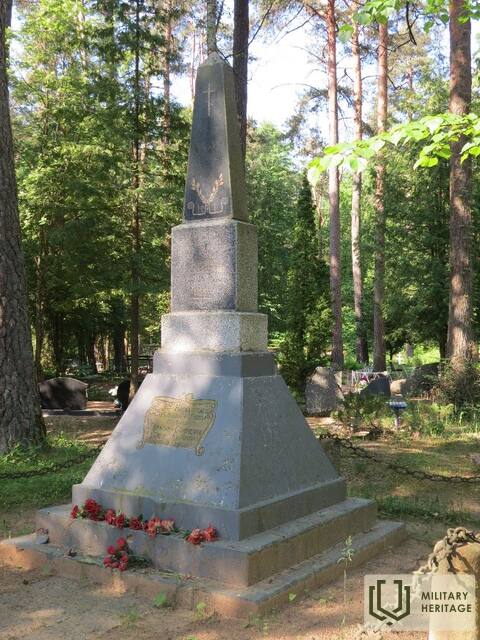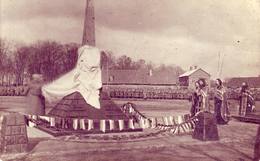Apie 3-iojo Kaukazo šaulių pulko karius, sušaudytus I-ojo pasaulinio karo metais Jēkabpilyje už kurstymą nepaklusti įsakymams
1916 m. gegužės 18 d. Gėgerių pusdvario griuvėsiuose (~7 km į pietus nuo Jēkabpilio už Brodiemo) 20.30 val. už kurstymą nepaklusti įsakymams buvo sušaudyti III Kaukazo šaulių pulko kariai. Nuosprendžio vykdymui vadovavo praporščikas Ravnyalichevas.
1916 m. kovo mėn. Jekabpilio placdarte vyko įnirtingi mūšiai. Čia Šiaurės fronto vyriausiasis vadas N. Ruzskis buvo numatęs pralaužti vokiečių 8-osios armijos frontą su toli siekiančiais planais – užimti Panevėžį. Tačiau tik puolimo pradžioje 5-osios armijos daliniams pavyko paveržti 2–3 km į priekį kai kuriose Jēkabpilio apygardos vietose. Priešo kontrataka privertė juos grįžti į pradines pozicijas.
5-oje armijoje suaktyvėjo antikarinė propaganda. Daugpilio stotyje 6-ojo Sibiro šaulių korpuso daliniai net atsisakė vykdyti kovinius įsakymus. Tarp nepatenkintųjų buvo ir 5-osios armijos 3-iojo Kaukazo šaulių pulko kariai, dislokuoti Jēkabpilio placdarmo priekyje. Pareigūnams pasiuntiniai įvardijo aktyviausiai pasisakančius prieš karą ir ragino sekti sibiriečių pavyzdžiu ir nepaklusti įsakymams.
1916 m. gegužės 18 d. rytą 3-iojo Kaukazo šaulių pulko vadas pulkininkas Arševas įsakė suimti pulko šaulius – majorą Aleksejų Kuznecovą, eilinius Gerasimą Serichenkovą, Grigorijų Jaluniną, Aleksejų Sokolovą, Semjoną Tzukurą ir perduoti teismui. Įsakymu Nr.141 pulkininkas Arševas lauko karo lauko teismo pirmininku paskyrė pulkininką leitenantą Rudnevą, nariais – kapitonus Ivanovą ir Voroncovą, štabo kapitonus Bek-Zeinalovą ir Petrovą.
Kapralas A. Kuznecovas ir šaulys G. Serichenkovas buvo apkaltinti tyčia tarp karių skleidę gandus. Šaulių G. Jalunino, A. Sokolovo ir S. Cukuros „nusikaltimas“ buvo toks pat kaip ir jų bendražygių, tačiau konstatuota, kad tai padaryta iš neapdairumo. Karo lauko teismo posėdis buvo trumpas. Teisėjai vienbalsiai pripažino kaltinamuosius A. Kuznecovą, G. Serichenkovą ir G. Jaluniną kaltais dėl karių kurstymo, iš anksto turėdamas tikslą sukelti netvarką pulke, taip pat ir fronto linijoje. Todėl pagal Įstatymų rinkinio XXII tomo 246 straipsnio 1 punktą buvo nuteisti mirties bausme sušaudant. Šauliai A. Sokolovas ir S. Tzukura buvo išteisinti, nes neįrodyta jų kaltė.
Lauko karo lauko teismo nuosprendis buvo nedelsiant perduotas pulko vadui, o pulkininkas Arševas surašė rezoliuciją ir nuosprendį: "Tvirtinu teismo nuosprendžiui. Įsakau praporščikui Ravnialičevui jį įvykdyti".
1917 m., nuvertus carą, bendražygiai perlaidojo žuvusiųjų palaikus į Jēkabpilio kapines, pastatė ir paminklą, bet jo nebaigė. Paminklas restauruotas 1950 m.
Užrašas ant paminklo:
3ГО КАВКАЗСКАГО
STRYLKOVAGO POLKA
RODYKLĖS
ГЕРАСИМ СРЕЧЕНКО
СЕМЁН КУЗНЕЦОВ
ГРИГОРИЙ ЯЛУНИН
Iluta Bērziņa, Jēkabpilio istorijos muziejus
Susijusi laiko juosta
Susijusios vietos
The First World War Russian Soldiers' Graves of the Brothers
It is located at the beginning of Jēkabpils State Gymnasium Alley towards the main entrance to the school.
Installed above the grave in memory of the fallen Russian soldiers of the 3rd Caucasus Rifle Regiment in 1915. 139 soldiers and two officers who fell on September 1, 1915 near Jēkabpils, during the attack, with the aim of breaking the front towards Panevezys, are buried in the brothers' cemetery.
The inscription on the obelisk:
3rd CAUCASIAN RIFLE REGIMENT HEROES OF OFFICERS AND SHIFTERS. ЗА ВЕРУ ЦАРЯ И ОТЕЧЕСТВА В СЛАВУ РУССКОГО ОРУДИЯ НА ПОЛЕ БРАНИ ПАВШИМ 1-GO SENTYABRYA 1915 ГODA В ОКРЕСТНОСТЯХ ЯКОБШТАТА. THERE IS NOTHING MORE THAT I LOVE, THAT SOMEONE WOULD PUT THEIR SOUL FOR THEIR FRIENDS.
Inscription on the concrete base:
GLORIOUS SMERTH BESLAVIYA KRASHE.
There is a limestone plaque with the names of 78 fallen soldiers and officers
The monument is surrounded by concrete posts connected by cast iron chains.
The author of the monument is Jēkabpils stonemason J. Sieriņš.






